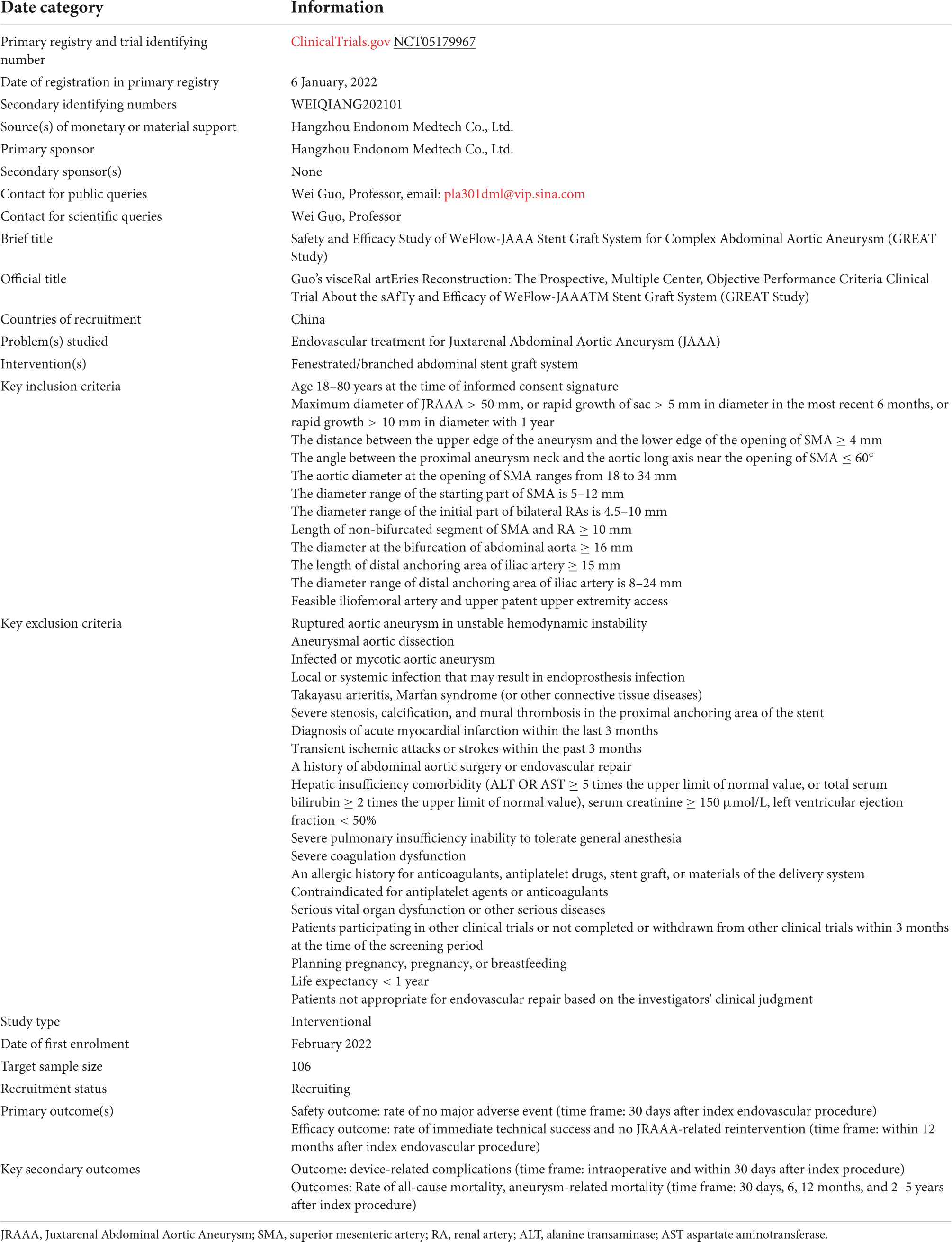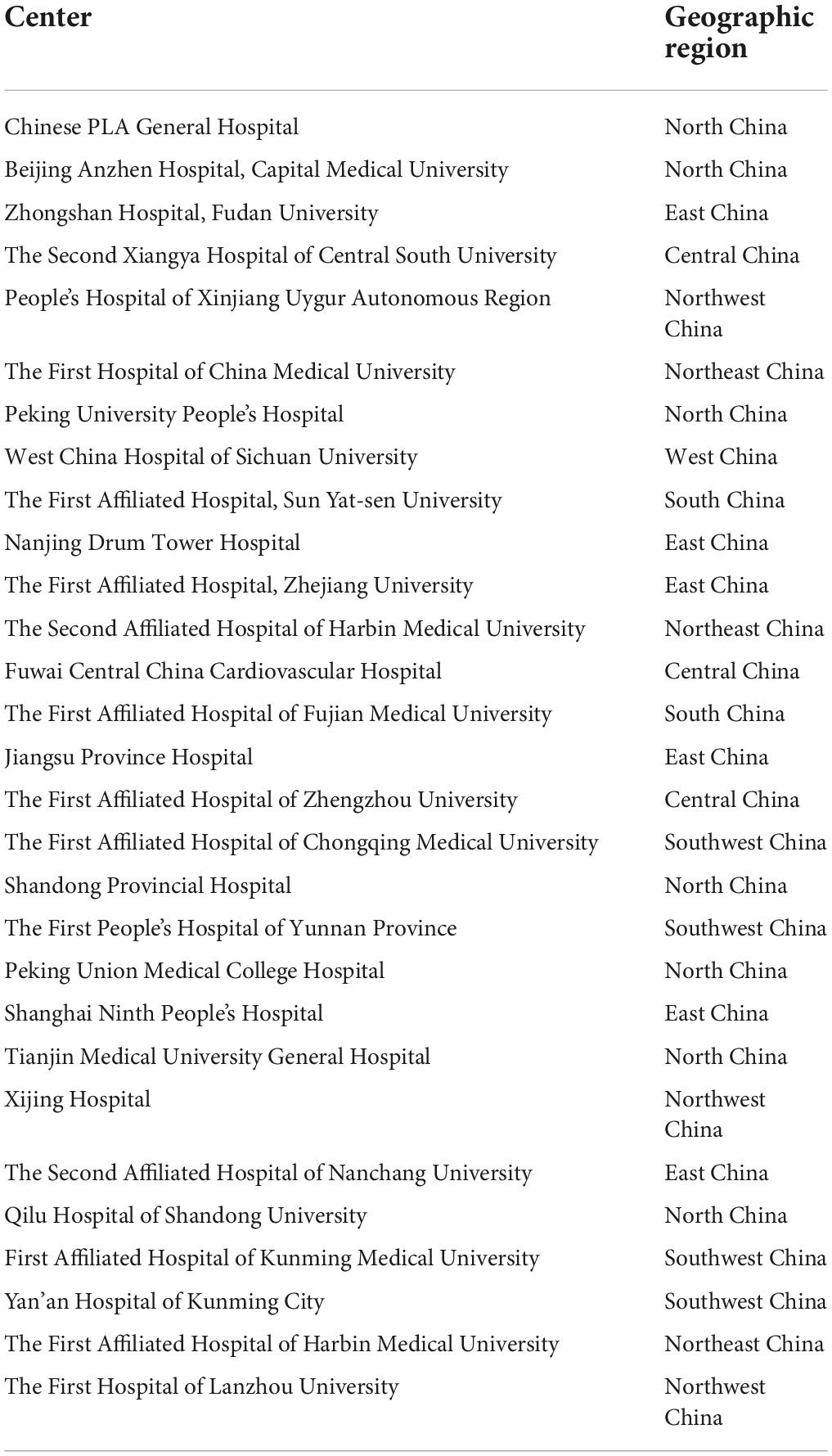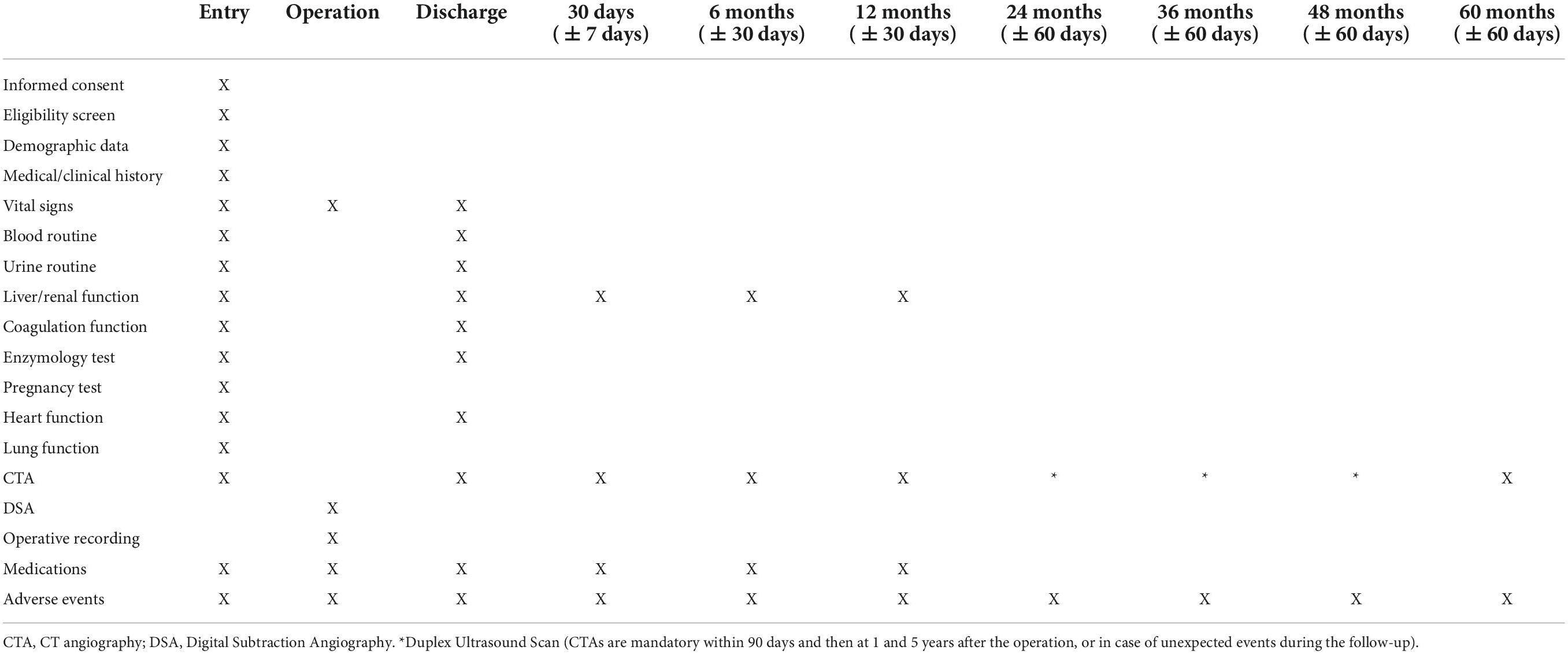- 1Department of Vascular Surgery, Chinese PLA General Hospital, Beijing, China
- 2Medical School of Chinese PLA, Beijing, China
Introduction: Juxtarenal abdominal aortic aneurysms (JRAAAs) are challenging to cure by traditional endovascular aortic repair (EVAR). Due to the inherent disadvantages of the customized fenestrated and/or branched aortic endografts (such as delayed cycles with a risk of aneurysm rupture, unavailable in emergency or confine operations), several off-the-shelf devices have been developed for the treatment of JRAAA. However, these devices being used in clinical trials have been proven to have a non-negligible risk of reintervention and inadequate anatomic applicability. We have developed a new off-the-shelf aortic endograft system (WeFlow-JAAA) with a mixed design of inner branches and modified fenestrations. The purpose of this cohort study is to assess the safety and effectiveness of the innovative aortic endograft system.
Methods and analysis: This is a prospective, multicenter, single-armed clinical trial cohort study. The enrolment will take place in 29 centers in China, and 106 adult patients with JRAAA will be enrolled in total. Clinical information and CT angiography (CTA) images will be collected and recorded. Patients will be followed up for 5 years. The primary safety endpoint is the rate of no major adverse event within 30 days after index EVAR. The primary efficacy endpoint is the rate of immediate technical success and no JRAAA-related reintervention within 12 months after the procedure.
Strengths and limitations of this study
• This is a prospective, multicentre, single-armed clinical trial cohort to evaluate the safety and efficacy of WeFlow-JAAA, a newly developed aortic endograft system, for the treatment of juxtarenal abdominal aortic aneurysms that are challenging for traditional endovascular aortic repair.
• A major strength of this study is that it evaluates a novel abdominal aortic endograft system based on a mixed design of inner branches and “mini-inner-cuff” reinforced fenestrations.
• The main limitations of this study are the regional limitation (China) and lack of control arms.
Introduction
Juxtarenal abdominal aortic aneurysm (JRAAA) poses significant challenges in endovascular aortic repair (EVAR). In the European Society for Vascular Surgery (ESVS) 2019 clinical practice guidelines on the management of AAA, JRAAA is defined as an aneurysm extending up to but not involving the renal arteries, i.e., a short neck (<10 mm) (1). During the past 20 years, custom-made fenestrated and/or branched aortic endografts (i.e., Cook Zenith Fenestration) have largely replaced open surgery for the treatment of anatomically suitable JRAAA (2, 3), which is also recommended by the ESVS2019 clinical practice guidelines on the management of AAA (1).
Due to the inherent disadvantages of the customized device (delayed cycles with a risk of rupture, unavailable in emergency or confine operation) (4, 5), several “off-the-shelf” devices have been developed for the treatment of JRAAA, such as Cook p-Branch and Endologix Ventana (6, 7). According to a recent systematic review, clinical outcomes for the off-the-shelf devices in the treatment of complex AAA are promising, with no 30-day mortality, a 1.7% rate of paraplegia, a 97.6% 30-day target vessel patency rate, and a 3.3% rate of type I endoleak (8). However, high rates of late postoperative reintervention and narrow anatomic indications hampered the development of devices for JRAAA. Sveinsson et al. (7) found a 48% rate of reintervention during the 5 years follow-up of p-Branch. The device study of Endologix Ventana was also placed on hold for a high reintervention rate of renal arteries (9). Additionally, these off-the-shelf fenestrated devices are only anatomically suitable for 30–40% of all patients (10, 11). Thus, a safer and more effective off-the-shelf device with less reintervention and wider anatomic indications for the treatment of JRAAA is needed.
In collaboration with Endonom Medtech (Hangzhou, China), we have developed a novel off-the-shelf modular endograft system (WeFlow-JAAA, Figure 1A) which consists of four components, a proximal body graft (Figures 1B,C), a distal bifurcated body graft (Figure 1D), iliac leg grafts (Figure 1E) and self-expanding branch grafts (Figure 1F). The proximal body graft (Figure 1C), with two standard inner branches (1.5 cm in length) of renal arteries (RA), one 3 mm “mini-inner-cuff” reinforced fenestrations with a sealing ring for superior mesenteric artery (SMA), and one scallop with a sealing ring for celiac axis (CA), has three important advantages. The first was inner branch design of bilateral renal arteries could significantly reduce branch instability or type III endoleak with matched branch stent grafts. The second advantage was that the modified fenestration reinforced with a 3 mm “mini-inner-cuff” and a sealing ring allows better seal at the attachment site, potentially reducing the risk of endoleak, without adding to the bulk of the device. The above two points lead to wider anatomic indications of this device, which was the third advantage. The anatomic indications of an aortic stent graft system depend on three aspects, including aortic related (especially the aortic diameter of the neck and branch level), branch vessel related, and approach related. The inner branch design could combine the benefits of external branch and fenestration and improve the anatomical fitness of aorta diameter. While the “mini-inner-cuff” reinforced fenestration could increase the sealing without compromising the approach-related anatomical fitness, which was precisely what the three preset guidewires (RAs, SMA) rather than preset catheters designed for.
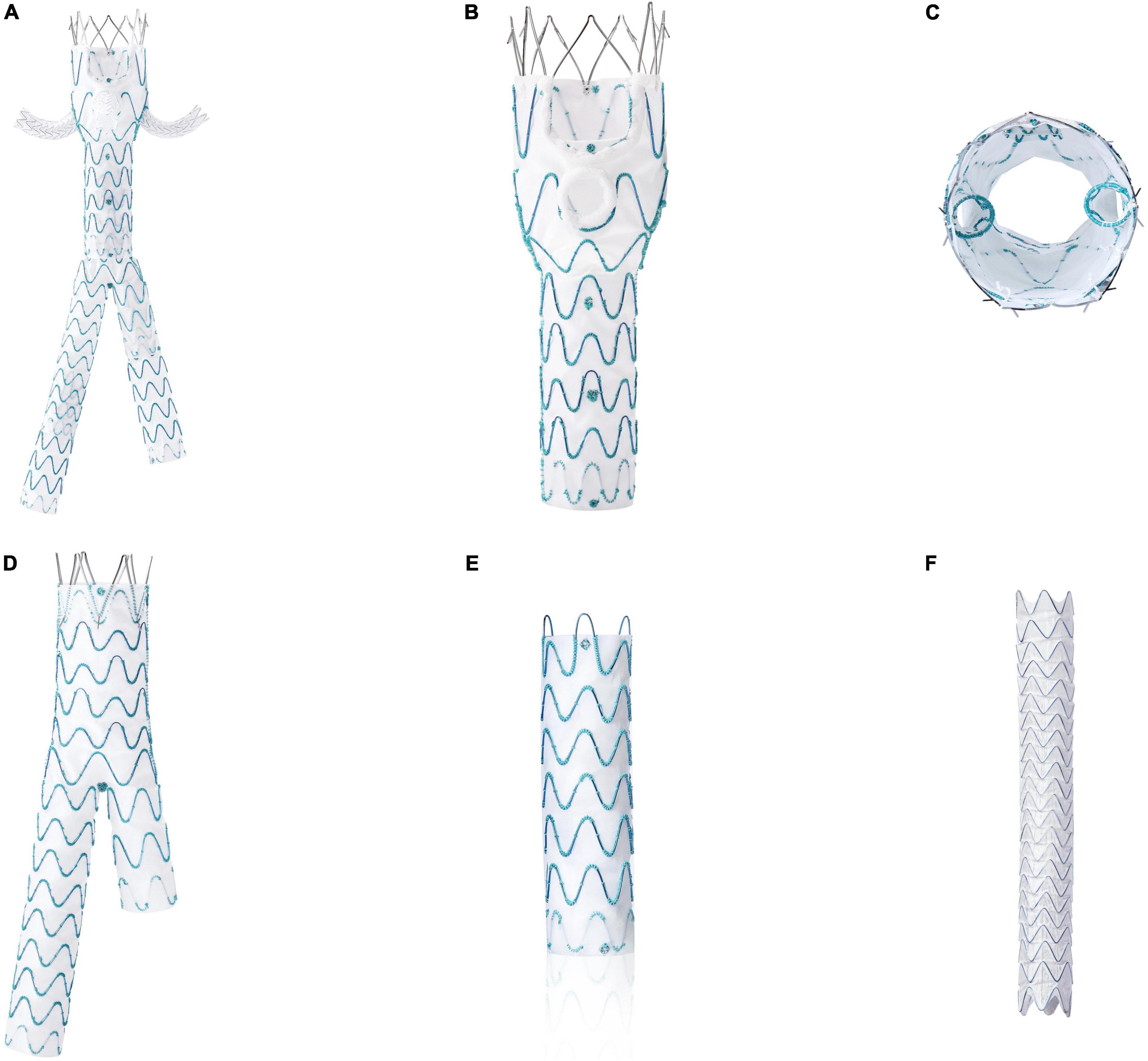
Figure 1. The WeFlow-JAAA system: a new, off-the-shelf, abdominal aortic stent graft system (A) for JRAAA, comprising a proximal body graft (B,C), a distal bifurcated body graft (D), iliac leg grafts (E) and self-expanding branch grafts (F). The most major characteristic of this device was the design of proximal body graft with two standard inner branches of renal arteries, one 3 mm “mini-inner-cuff” reinforced fenestration for superior mesenteric artery, and one scallop for celiac axis.
The first-in-human (FIM) study (NCT04745546) of WeFlow-JAAA was initiated in October 2019 and is being conducted in a single center (data unpublished). This FIM study involved a total of 15 patients with 14 JRAAA and 1 suprarenal AAA, and all patients have currently completed at least 6 months of follow-up imaging. The main objective of this study was to evaluate the safety and effectiveness of this abdominal aortic stent graft system (WeFlow-JAAA) in preparation for its dissemination to maximumly benefit patients with JRAAA.
Methods and analysis
This study was designed following the Standard Protocol Items “Recommendations for Interventional Trials statement” and is registered with the US National Institute of Health (Table 1). The protocol ID is WEIQIANG202101. The actual study start date was 23 February 2022, and the estimated study completion date is 31 December 2028.
Study design
This is a prospective, multicenter, single-arm, cohort study evaluating the safety and efficacy of a novel fenestrated and branched stent graft system for endovascular repair of JRAAA. This study is being initiated by the Chinese PLA General Hospital and will involve patients from an additional 28 high-volume tertiary referral hospitals across all geographic areas of China (Table 2). All participating hospitals have performed endovascular treatment in more than 50 patients with anatomically complex abdominal aortic aneurysms in the last 5 years.
Study endpoints
Primary safety endpoint
The primary safety endpoint is the rate of survival without major adverse events (MAEs) within 30 days after the index endovascular procedure. The MAEs include all-cause death, myocardial infarction, intestinal ischemia, renal failure needing continuous dialysis, respiratory failure, stroke, and permanent paraplegia.
Primary efficacy endpoint
The primary efficacy endpoint is the rate of clinical success within 12 months after the operation. Clinical success included immediate technical success (which is defined as correct system deployment without any unintentional occlusion of the aortic visceral branches or both hypogastric arteries, no type I or III endoleak, or conversion to open surgery), and no aneurysm or device-related death, no type I or III endoleak, no graft infection or thrombosis, no aneurysm expansion > 5 mm or rupture, no conversion to open surgery, no graft migration, or a failure of device integrity within 12 months after the procedure.
Secondary safety endpoints
The following secondary safety endpoints will be evaluated: all-cause mortality, aortic-related mortality, the incidence of device-related adverse events, and the incidence of serious adverse events (resulting in death or serious deterioration of health) before discharge and at 30 days, 6 months, 12 months, and 2–5 years postoperatively.
Secondary efficacy endpoints
The following secondary efficacy endpoints will be evaluated: the patency rate of postoperative branches, the incidence of type I/III endoleak, graft migration, open surgery conversion, and JRAAA-related reintervention at 6 months, 12 months, and 2–5 years postoperatively.
Patient recruitments
We are intent to recruit 106 patients between 18 and 80 years who are diagnosed with JRAAA. As the JRAAA is relatively common in clinical practice, the patient recruitment is non-competitive, and the enrollment number of each center shall be evenly distributed as far as possible to ensure the representativeness of the region. Of course, appropriate adjustments will be made according to the actual situation such as the enrollment process of each center. Figure 2 shows the time schedule of the study.
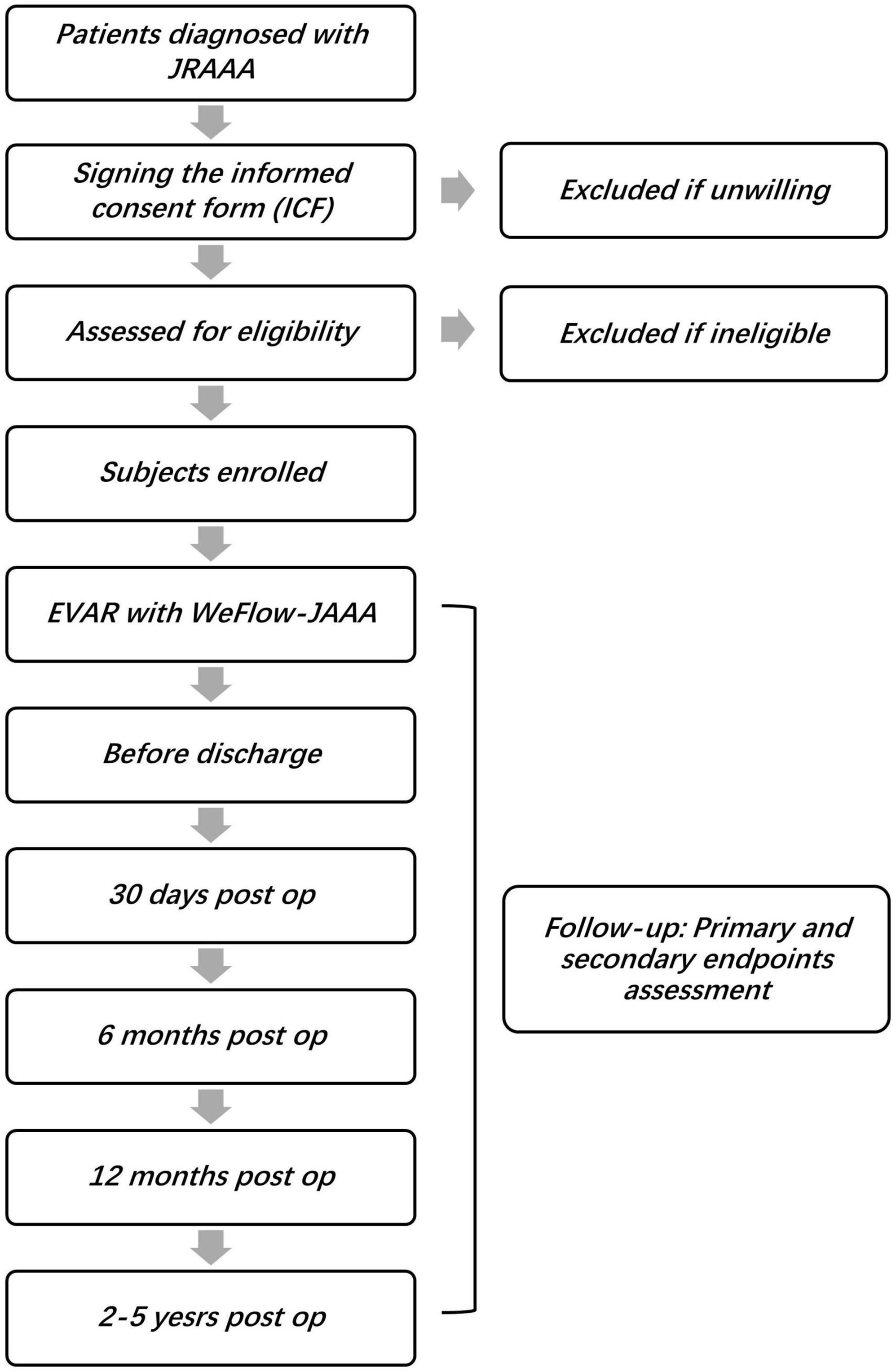
Figure 2. The study flow chart. (JRAAA, juxtarenal abdominal aortic aneurysm; EVAR, endovascular aortic repair; op, operation).
Table 1 gives a detailed overview of the inclusion and exclusion criteria. Vascular surgeons will judge the patients’ eligibility according to the criteria. Engineers from Hangzhou Endonom Medtech will provide on-site guidance regarding device manipulations for the early cases treated in participating hospitals.
Device description
The design concept of WeFlow-JAAA is to revascularize the renovisceral arteries using a fenestration-and-branch mixed stent graft with two standard inner branches for the renal arteries, one 3 mm “mini-inner-cuff” reinforced fenestration for SMA, and one scallop for celiac axis (CA). The advantages of this mixed design have been proposed in the introduction.
The proximal body graft, constructed of woven polyester fabric sewn to self-expanding nitinol stents, consists of a bare stent part, an upper part (two fenestrations for SMA and CA, two inner branches for RAs), and a lower part that has a smaller diameter than the upper part (Figures 1B,C). A radiopaque “o” marker fixed at the 12 o’clock of the proximal end and two “I” markers are, respectively, fixed at the 4 and 8 o’clock positions of the proximal end (two sides of the scallop), coupled with one “o” marker between the scallop of CA and the fenestration of SMA to allow accurate positioning. The outlets and inlets of the inner branch and the fenestration of SMA are outlined by circular markers to facilitate cannulation. Two radiopaque “o” markers are positioned in the proximal end and distal end of the lower portion to identify the distal landing position and overlapping length with a distal bifurcated body graft.
The bare stent at the proximal end of the proximal body graft contains barbs for additional fixation of the device. The bare stent portion has lengths of 13 and 15 mm. The upper part of the proximal body graft has a diameter of 20–38 mm (2 mm increments) and lengths of 26 and 31 mm. The two inner branches sewn to the internal face of the upper part and the outlets are designed at the same level. The inner branches have three diameters available, 6, 7, and 8 mm, with a fixed length of 15 mm. The fenestration of SMA is positioned at 6 o’clock, with two diameters available, 8 and 10 mm. The lower part of the stent graft is 50–100 in length and 16–30 mm in diameter (2 mm increments). A total of 10 series with 41 types of WeFlow-JAAA endografts are available, all of which require a 22F inner diameter femoral sheath introducer, regardless of the stent graft size. To facilitate visceral artery cannulation, the delivery system of the system has three preloaded guidewires for the two inner branches and fenestration of SMA.
The self-expanding bridging branch stent graft (for the reno-visceral arteries) is constructed using a unique interwoven nitinol wire sandwiched by two thin layers of expanded polytetrafluorethylene (ePTFE), which can provide favorable flexibility, fracture resistance, and low-profile features. The branch graft diameter is 6–12 mm at the proximal end and 5–10 mm at the distal end, and the stent graft length is 20–150 mm. An inner 8–9F introducer sheath is required, depending on the stent graft diameter (8F: 6–9 mm; 9F: 10–12 mm).
The distal bifurcated body graft and iliac legs are constructed of woven polyester fabric sewn to self-expanding nitinol stents. The bifurcated body graft also has barbs in the proximal portion to prevent graft migration. A variety of sizes for distal bifurcated body graft and iliac legs are available to accommodate the different diameters of the proximal body graft and individual arterial anatomical variations.
The detailed product size series is shown in Supplementary Appendix 2.
Endovascular technique
The index endovascular procedures are performed in a hybrid operating room under fluoroscopic control with the patient under general anesthesia. After surgical exposure of the left brachial artery, intravenous heparin loading is started with a bolus of 100IU/kg body weight to achieve an activated clotting time of at least 250 s. The activated clotting time would be measured at 30 min intervals throughout the procedure. A subsequent dose of heparin will be administered if required. The left brachial artery is directly punctured to establish the access through which the thoracic descending aorta is catheterized. An 8F long sheath is introduced into the descending thoracic aorta. The bilateral common femoral artery is percutaneously punctured and a 5/6Fsheath inserted. Two Perclose ProGlide devices were exchanged to provide “preclose” sutures on the main body side, while one on the contralateral side.
Detailed visualization of the operative procedure is shown in Supplementary Appendix 1. After the endovascular repair is finished, selective angiography is used to identify endoleaks, stent graft migration, stenosis, or occlusion. Relining bare metal stents are not routinely used unless a significant stent graft compression is noted.
Medications
Single antiplatelet therapy (aspirin or clopidogrel) is recommended as a long-term treatment. Other medical treatments (such as anticoagulation, antihypertensive, antibiotic therapy, et al.) will be administered depending on the individual’s comorbidities.
CT angiography
CT angiography (CTA) scans in the arterial and venous phases from the supra-aortic arch to the common femoral arteries will be performed preoperatively, before discharge, at 6 and 12 months postoperatively. CTAs are mandatory within 90 days and then at 1 and 5 years after the operation, or in case of unexpected events during the follow-up. For patients with substantially impaired renal function, postoperative CTA will be replaced by plain CT and Doppler ultrasonography.
Patient timeline
Each patient will attend a total of 10 visits, including one preoperative visit and nine postoperative visits for eligibility screening, baseline data extraction, and safety/efficacy evaluation of the stent graft system (Table 3). Unless an unexpected event occurred, Doppler ultrasonography rather than CTA is planned for 2, 3, and 4 years postoperatively. Adverse events and defects of the devices will be strictly monitored throughout follow-up.
Data extraction, entry, and monitoring
The clinical database contains the data of participants’ electronic medical records (EMR), CTA images, and follow-up conditions. Preoperative data will be extracted from the EMR and entered into the database before the operation, while postoperative in-hospital data will be collected within 2 weeks after discharge. The headline of each patient’s DICOM format image at each timepoint will be modified before data extraction, with the identifying information (patient ID, name, date of birth) replaced by a random 6-digit number. Preoperative CTA image data will be extracted before the operation, while postoperative CTA image data will be extracted within 2 weeks after the image data is acquired. Postoperative CTA images obtained at each follow-up timepoint will be independently analyzed by two experienced vascular surgeons who are blinded to the CTA findings at the preoperative or other postoperative timepoints, patients’ EMR, and follow-up information. After the completion of data extraction, the discrete data from CTA scans will be integrated into one database according to the predesigned 6-digit number. All CTA images will be measured and assessed by the 3Mensio workstation (V.8.1; 3Mensio Medical Imaging). At least 10% of the total CTA scans (including preoperative and postoperative scans) will be randomly selected and re-analyzed by the two vascular surgeons to assess interobserver and interobserver agreement.
Data will be registered via an electronic data capture system (EDC) and centrally stored in a secure password-protected server. Double data entry, range checks, and logical consistency checking methods will be used to ensure the quality of data. Clinical research associates who are independent of the investigators will review the study documentation and records held at each site to ensure that the study is conducted in compliance with the regulatory requirements.
Sample size calculation
Currently, no guiding principle exists regarding objective performance criteria (OPC) for a fenestrated/branched stent graft system in China. As the endpoints of this study differ from that of the p-Branch (off-the-shelf) and Zenith Fenestrations (customized) studies, the expected endpoint incidences were obtained based on data extracted from previous studies (7, 12). We hypothesized that the performance of the WeFlow-JAAA stent graft system will not be inferior to that of the p-Branch and be similar to that of Zenith fenestrations.
In this setting, combined with the current experience of clinical experts, it is estimated that the objective performance of clinical success rate at 12 months (the primary efficacy endpoint) is set to 70% and the target of WeFlow-JAAA is set to 85%. According to statistical requirements, we used 0.025 as α and 0.10 as β for a single-sided test. A sample size of 82 cases was thus obtained. Besides, the objective performance of the rate of survival without MAEs in 30 days (the primary safety endpoint) is set to 71% and the target of WeFlow-JAAA is set to 86%. As α = 0.025 and β = 0.10 for a single-sided test, a sample size of 80 patients is required. Both endpoints need to be achieved. Considering the shedding, the sample size increased by 20%. At least 103 subjects are required for this study eventually. Considering the facilitation of the study center allocation, it is expected to enroll 106 patients. The sample size is calculated as follows:
(PT presents the expected rate of the test instrument and P0 presents the target value).
Statistical analysis
The analysis will be done on all participants of the study as a primary analysis population. Patient demographic data, safety endpoints, and efficacy endpoints will be analyzed descriptively, with continuous data expressed as means with SD or medians (IQR), and categorical data will be expressed as numbers and percentages.
The primary safety and efficacy endpoints will be summarized as numbers and percentages with their two-sided 95% exact CI, using the Clopper-Pearson method. In addition, the Kaplan-Meier method will be used to estimate the cumulative rate of each endpoint. Statistics calculations will be performed using SAS software V.9.4 (SAS Institute).
Patient and public involvement
Patients or the public will not be involved in the design, conduct, reporting, or dissemination plans of our study.
Ethics statement
The studies involving human participants were reviewed and approved by the Ethics Committee of Chinese PLA General Hospital. The patients/participants provided their written informed consent to participate in this study.
Author contributions
J-PG and H-PZ drafted the manuscript. WG initiated the design of the study, while H-PZ, XJ, JX, X-HM, L-JW, M-HZ, and Y-LX helped with the implementation. All authors read and approved the final version of the manuscript.
Funding
This study was funded by Hangzhou Endonom Medtech Corporation (Hangzhou, China) (Grant No. WEIQIANG202101).
Acknowledgments
We would like to thank all investigators and participants of the study.
Conflict of interest
The authors declare that the research was conducted in the absence of any commercial or financial relationships that could be construed as a potential conflict of interest.
Publisher’s note
All claims expressed in this article are solely those of the authors and do not necessarily represent those of their affiliated organizations, or those of the publisher, the editors and the reviewers. Any product that may be evaluated in this article, or claim that may be made by its manufacturer, is not guaranteed or endorsed by the publisher.
Supplementary material
The Supplementary Material for this article can be found online at: https://www.frontiersin.org/articles/10.3389/fcvm.2022.1013834/full#supplementary-material
References
1. Wanhainen A, Verzini F, Van Herzeele I, Allaire E, Bown M, Cohnert T, et al. Editor’s choice – European society for vascular surgery (ESVS) 2019 clinical practice guidelines on the management of abdominal aorto-iliac artery aneurysms. Eur J Vasc Endovasc Surg. (2019) 57:8–93. doi: 10.1016/j.ejvs.2018.09.020
2. Belczak SQ, Lanziotti L, Botelho Y, Aun R, Silva ES, Puech-Leão P, et al. Open and endovascular repair of juxtarenal abdominal aortic aneurysms: a systematic review. Clinics. (2014) 69:641–6. doi: 10.6061/clinics/2014(09)11
3. Jones AD, Waduud MA, Walker P, Stocken D, Bailey MA, Scott DJA. Meta-analysis of fenestrated endovascular aneurysm repair versus open surgical repair of juxtarenal abdominal aortic aneurysms over the last 10 years. BJS Open. (2019) 3:572–84. doi: 10.1002/bjs5.50178
4. Gallitto E, Faggioli G, Spath P, Pini R, Mascoli C, Ancetti S, et al. The risk of aneurysm rupture and target visceral vessel occlusion during the lead period of custom-made fenestrated/branched endograft. J Vasc Surg. (2020) 72:16–24. doi: 10.1016/j.jvs.2019.08.273
5. Katsargyris A, Uthayakumar V, Marques de Marino P, Botos B, Verhoeven EL. Aneurysm rupture and mortality during the waiting time for a customised fenestrated/branched stent graft in complex endovascular aortic repair. Eur J Vasc Endovasc Surg. (2020) 60:44–8. doi: 10.1016/j.ejvs.2020.03.003
6. Quiñones-Baldrich WJ, Holden A, Mertens R, Thompson MM, Sawchuk AP, Becquemin JP, et al. Prospective, multicenter experience with the ventana fenestrated system for juxtarenal and pararenal aortic aneurysm endovascular repair. J Vasc Surg. (2013) 58:1–9. doi: 10.1016/j.jvs.2012.12.065
7. Sveinsson M, Sonesson B, Dias N, Björses K, Kristmundsson T, Resch T. Five year results of off the shelf fenestrated endografts for elective and emergency repair of juxtarenal abdominal aortic aneurysm. Eur J Vasc Endovasc Surg. (2021) 61:550–8. doi: 10.1016/j.ejvs.2020.12.012
8. Georgiadis GS, van Herwaarden JA, Antoniou GA, Hazenberg CE, Giannoukas AD, Lazarides MK, et al. Systematic review of off-the-shelf or physician-modified fenestrated and branched endografts. J Endovasc Ther. (2016) 23:98–109. doi: 10.1177/1526602815611887
9. de Niet A. Endovascular Approaches To Complex Aortic Aneurysms. Netherlands: University of Groningen (2020).
10. Farber MA, Vallabhaneni R, Marston WA. “Off-the-shelf” devices for complex aortic aneurysm repair. J Vasc Surg. (2014) 60:579–84. doi: 10.1016/j.jvs.2014.03.258
11. Ou J, Cheng SW, Chan YC. The compatibility of p-branch “off-the-shelf” fenestrated endovascular graft in Asian patients with juxtarenal aortic aneurysm. J Vasc Surg. (2015) 61:1417–23. doi: 10.1016/j.jvs.2014.12.061
12. Oderich GS, Greenberg RK, Farber M, Lyden S, Sanchez L, Fairman R, et al. Results of the United States multicenter prospective study evaluating the Zenith fenestrated endovascular graft for treatment of juxtarenal abdominal aortic aneurysms. J Vasc Surg. (2014) 60:.1420–8.e1–5. doi: 10.1016/j.jvs.2014.08.061
Keywords: abdominal aortic aneurysm, juxtarenal, endovascular aortic repair, endovascular repair, WeFlow-JAAA
Citation: Gao J-P, Zhang H-P, Jia X, Xiong J, Ma X-H, Wang L-J, Zhang M-H, Xu Y-L and Guo W (2022) A prospective, multicenter, single-arm clinical trial cohort to evaluate the safety and effectiveness of a novel stent graft system (WeFlow-JAAA) for the treatment of juxtarenal abdominal aortic aneurysm: A study protocol. Front. Cardiovasc. Med. 9:1013834. doi: 10.3389/fcvm.2022.1013834
Received: 07 August 2022; Accepted: 13 September 2022;
Published: 28 September 2022.
Edited by:
Konstantinos Spanos, University of Thessaly, GreeceReviewed by:
Karin Pfister, University Medical Center Regensburg, GermanyEdoardo Pasqui, University of Siena, Italy
Copyright © 2022 Gao, Zhang, Jia, Xiong, Ma, Wang, Zhang, Xu and Guo. This is an open-access article distributed under the terms of the Creative Commons Attribution License (CC BY). The use, distribution or reproduction in other forums is permitted, provided the original author(s) and the copyright owner(s) are credited and that the original publication in this journal is cited, in accordance with accepted academic practice. No use, distribution or reproduction is permitted which does not comply with these terms.
*Correspondence: Wei Guo, Z3Vvd2VpcGxhZ2hAc2luYS5jb20=
†These authors have contributed equally to this work and share first authorship
 Jiang-Ping Gao
Jiang-Ping Gao Hong-Peng Zhang
Hong-Peng Zhang Xin Jia1
Xin Jia1 Jiang Xiong
Jiang Xiong Wei Guo
Wei Guo